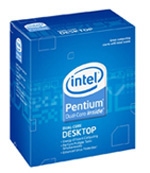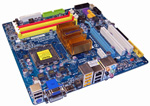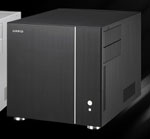Intel HTPC
We detailed our assumptions about the HTPC configurations in the introduction to the AMD HTPC. You may want to look back at the considerations. We assume the end user has already selected an HDTV or monitor and a sound system. Very few end users need a TV tuner anymore so we are not making that recommendation. We also assume the primary use of the HTPC computer is to play, store, and stream Blu-ray movies and other video entertainment.
| Intel HTPC System | ||
| Hardware | Component | Price |
| Processor | Intel Pentium Dual-Core E5200 Wolfdale (Dual-core 2.5GHz, 45nm, 65W, 2MB Shared L2, 800FSB) |
$70 |
| Cooling | CPU Retail HSF | - |
| Video | On-Board | - |
| Motherboard | Gigabyte GA-E7AUM-DS2H GF9400 Micro ATX | $130 |
| Memory | Patriot Viper Model PVS24G6400LLK 4GB DDR2-800 4-4-4 ($52 less $25 Rebate) |
$27 |
| Hard Drive | WD Caviar Green WD10EACS 1TB 32MB cache - OEM | $90 |
| Optical Drive | LG BD/HD DVD / 16x DVD+/- RW GGC-H20L - Retail | $110 |
| Audio | On-Board | - |
| Case | Antec NSK2480 Black/Silver Micro ATX Case Includes 80 Plus Certified 380W PSU |
$120 |
| Power Supply | Earthwatts 380W Included with Case | - |
| Base System Total | $546 | |
| Input | Logitech Cordless Desktop EX110 USB RF Wireless Keyboard and Optical Mouse |
$30 |
| Operating System | Microsoft Vista Home Premium SP1 (for System Builders) | $99 |
| Complete System Bottom Line | $676 | |
 |
As discussed in the Intel Entry PC, the E5200 is an excellent value in the Intel CPU line. Anything lower priced is generally a lot worse in performance, but higher priced CPUs do not gain that much in performance. At the new lower price of $70, the dual-core E5200 is also an excellent match to an NVIDIA 9400 chipset motherboard. It also doesn't hurt that the E5200 is rated at 65W TDP, which will help in keeping the HTPC as quiet as possible.
 |
Our motherboard choice for the Intel HTPC is the $130 Gigabyte GA-E7AUM-DS2H featuring the NVIDIA GeForce 9400 chipset. Our motherboard reviews found this chipset and the GF9300 a better choice than G45 in Intel HTPC systems due to superior video playback and overall system performance. Some users have reported that the stock Intel CPU heat sink touches the chipset heatsink on this motherboard and they found the heatsink fit best and worked best by rotating the heatsink 90 degrees. For best results, check the fit and best positioning before completing the mount of the heatsink/fan.
 |
The HTPC case is one of those very personal options in building an HTPC computer. Some like the small cube form factor that can easily hide next to books on a shelf, while others prefer the audio component look. If prefer the "audio component" look in your HTPC the Antec New Solution NSK2480 case selected for the AMD HTPC system should be your choice. If you prefer to tuck away a cube on the bookshelf, the Lian Li PC-V350B is a better choice. The Lian Li does not come with a power supply, however, so you will need to add a PSU if you choose the Lian Li cube. Our pricing tables on both systems list the Antec NSK2480.
The rest of the components are the same as those found in the AMD HTPC system. For detailed information on the rest of the components chosen for the Intel HTPC, please refer to the detailed discussion on the AMD HTPC page.
AMD systems have held the lead for some time in HD video and HTPC boxes. The AMD advantage was large enough that AT hadn't recommended an Intel HTPC build until the December 2008 Buyers' Guide. The NVIDIA GeForce 9300/9400 chipsets have done a lot to level the HD and HTPC playing field - but at a premium price. The Intel HTPC problem was never the CPU but rather the motherboard chipset. That is the reason we can combine a cheaper Intel CPU with an NVIDIA GF9400 chipset motherboard to create a competent HTPC box.
While we can't tell you HD playback capabilities are completely equal between AMD and Intel today, we can tell you that both HTPC builds provided smooth, stutter-free Blu-ray playback. Certainly that is the primary concern of most HTPC system builders.










65 Comments
View All Comments
Wesley Fink - Thursday, May 14, 2009 - link
That is the way it is on the Intel side. We have to go up to the $169+ range to get VT on Intel and quite frankly, maybe 1% of people might ever run XP mode in Win7.If running the Windows Virtual PC under Windows 7 for XP Mode is important to you, then moving to the E8x00 range or the E6x00 are the best VT options. That would blow the Budget out the door, and make the Intel selections not competitive in the Budget Range.
Do you work for AMD? This is a really minor nag for the vast majority of our readers, and as I'm sure you aware, for a Budget PC if this feature really matters to you then go for an AMD system in the budget price range.
nycromes - Thursday, May 14, 2009 - link
I think their point was/is that there is no mention of it in the article. It is nice to know what you get and what you don't get for these kind of systems. I don't think many will need the VT feature, but it could have still been presented in the article for those that might need it. I wouldn't change the recommendations, but just a small blurb about it would probably suffice.Of course, if they read the comments, there is plenty of mention of it so it doesn't really matter anymore.
Gary Key - Thursday, May 14, 2009 - link
We had strict budget numbers to meet for this guide. We had to select the entry level Intel processors due to cost and still provide a decent set of components around it. We added a statement about VT support to the processor descriptions.HelToupee - Thursday, May 14, 2009 - link
This will be a boon to those using non-Microsoft OSes for our HTPC's XBMC, my HTPC OS of choice has supported nVidia's accelerated video playback for quite awhile now. Unfortunately, players have not been able to take advantage of AMD/ATI's Linux drivers due to AMD/ATI being slow to release specs/headers. Acelleration on nVidia is supported in most major Linux video players by default, all you have to do is have the nVidia binary driver installed.kleinwl - Thursday, May 14, 2009 - link
It's probably worth mentioning that a core i7 makes a great cpu in an HTPC. While it blows the budget, if you are looking to upscale DVDs using ffdshow (or the like) to fit your 52" screen, I would suggest that you do not skimp on the cpu power. While ffdshow is a nightmare to get properly configured (thousands of options, no consistent recommendations), once you do, you can have a viewing experience close to that of an oppo. However, ffdshow can be a resource hog, and thus I recommend pushing the cpu spec as high as you can aford.Spoelie - Friday, May 15, 2009 - link
1. Size of the screen is not directly related to resolution (and thus scaling power needed). There are large plasma screens with the same resolution as a 17" LCD. A modern 52" TV will 'only' have a resolution of 1920x1080, and as such BR will need no scaling, and decoding DVDs is such a light load that there's plenty left for upscaling.There's a reason media tanks do not use super-fast general purpose cpus. They just aren't needed for playing back stuff, even with scaling.
The only valid reason to push cpu power is for transcoding.
2. Ideal = low power, noise, heat, consumption. Not something one would associate with an i7.
Nowadays, even though I have a HTPC, I'm of the opinion you're better of with a media server/transcoder somewhere in a back room and a networked media tank next to the screen instead of a single device to do both tasks.
HOOfan 1 - Thursday, May 14, 2009 - link
Just an FYInecrohippy - Thursday, May 14, 2009 - link
biostar t-series motherboard amd athlon x2 3.0ghz 4gb ram 500watt moduler psu decent case nvidia gtx geforce 260 896mb video card xp pro $600 after rebate $750 in the first place changed cpu from 3ghz to 4.5ghz a great gaming rig for the money....smoken. I had keyboard,mouse,and 19inch viewsonicmrubermonkey - Thursday, May 14, 2009 - link
With these Intel systems people will not be able to do hardware virtualization of Windows XP from within Windows 7, but people with AMD systems should be alright.JarredWalton - Thursday, May 14, 2009 - link
I think you're talking about a very small group of people that will even need that feature. Virtual XP is a "fix" from MS that's only for older programs that refuse to work right with Win7, and even then you're running with the equivalent of old unaccelerated GPUs. If you have a program that works with Vista, it should be fine on Win7. If you need virtualization that badly, though, by all means make sure you buy a CPU that supports hardware VT. (Intel will be releasing updated versions of many CPUs with VT enabled in the near future.)